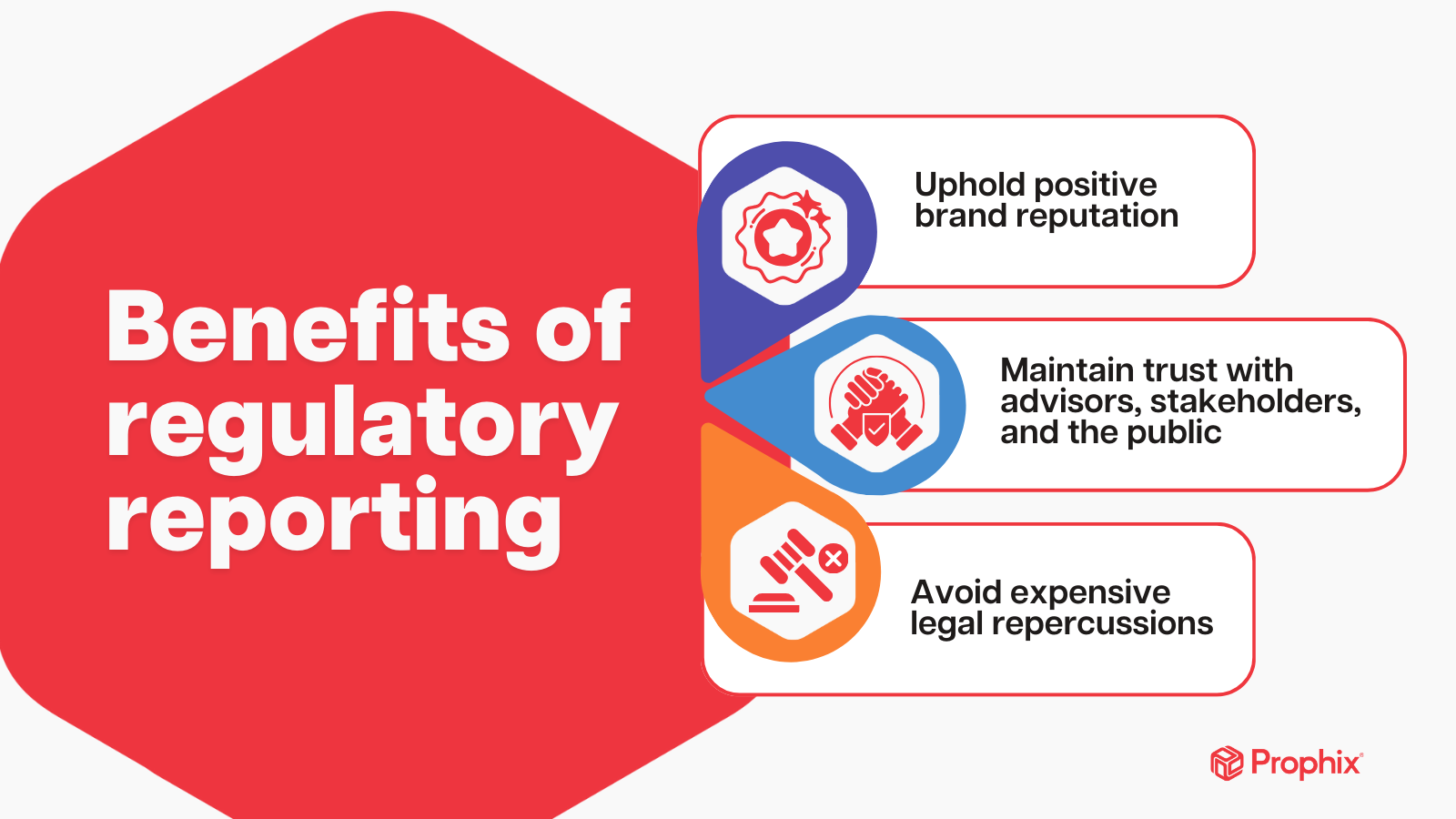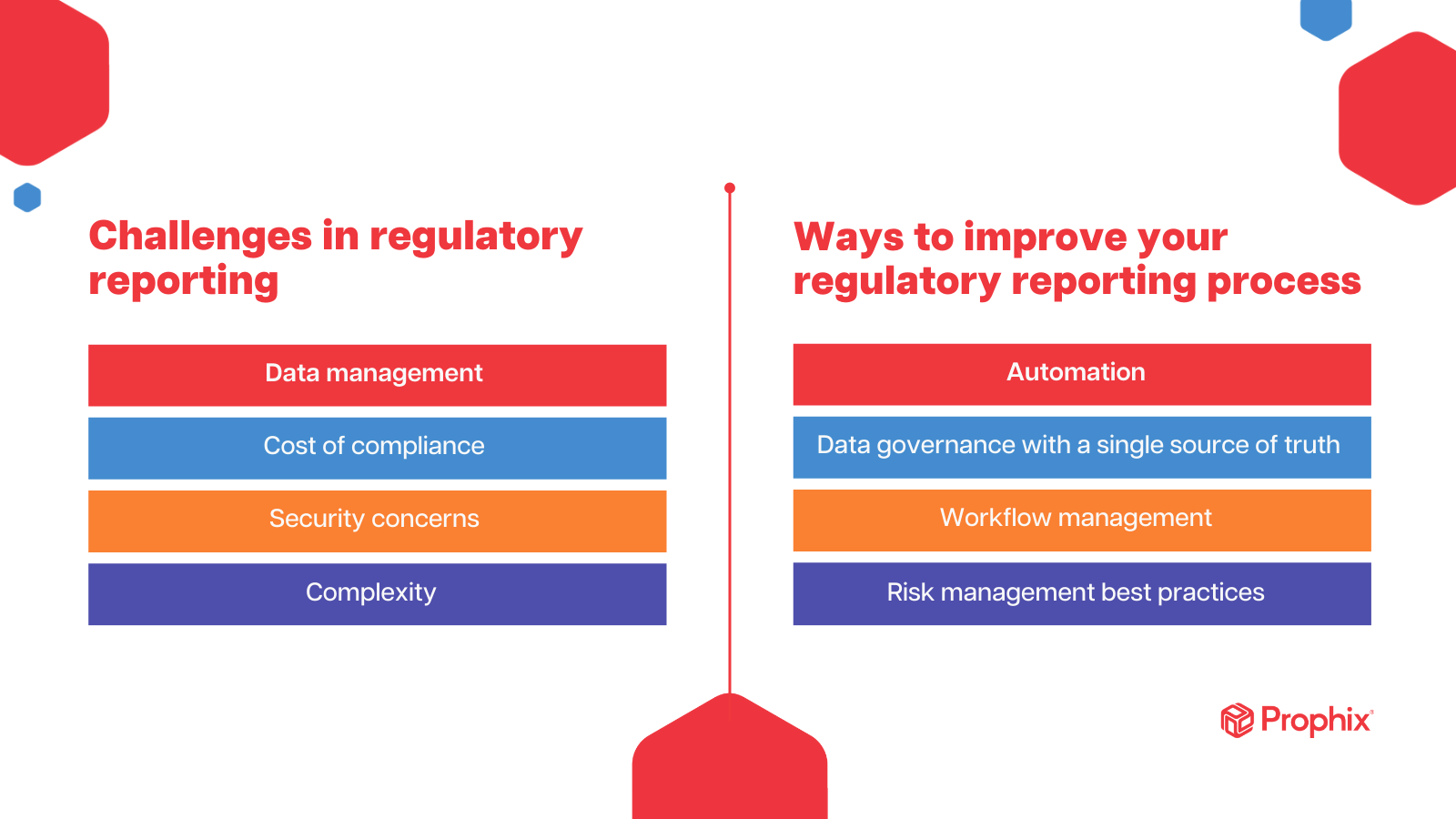What is regulatory reporting and why is it important?
Navigating the world of finance can be complex, especially when it comes to regulatory reporting. But what exactly is it, and why should you care?
This article explains regulatory reporting, breaking it down into simple terms that anyone can understand.
So, whether you're a seasoned finance leader or simply curious about the industry, join us as we explore its importance, benefits, challenges, and how to improve it. We’ll cover:
What is regulatory reporting?
Regulatory reporting is how a company demonstrates its financial and operating activities comply with various standards and regulations as part of its financial reporting process. And in the context of the regulatory reporting process, companies must submit their reports to the relevant governing body for review.
However, it's important to note that the specific governing body can vary depending on the jurisdiction and the nature of the company's activities. For example, in the United States, companies might submit these reports to the Securities and Exchange Commission (SEC) or the Federal Reserve.
What are the goals of regulatory reporting?
The goal of regulatory reporting is to improve transparency in companies’ financial and operating activities, regardless of where they operate. Regulatory reporting also helps establish trust between competitors in the same industry, as they can be confident that other companies are adhering to the same standards.
Investors and stakeholders also stand to benefit from precise and up-to-date information on an organizations’ financial health via regulatory reports, so they can make more informed decisions. In addition, regulatory reporting can help finance leaders effectively identify and manage risk, supporting the long-term sustainability of an organization.
What happens if you don't follow regulatory reporting guidelines?
Companies that don’t follow regulatory reporting guidelines are at risk of financial penalties, reputational damage, limitations on their activities, additional barriers to approval, or even imprisonment. For example, BMW was fined €8.8 million by South Korea in 2018 for failing to comply with recall regulations.
In addition, non-compliance can lead to other indirect costs, including time and resources on legal consultations, investigations, and remedial actions. Non-compliance could also result in loss of consumer trust and business opportunities.
In addition to financial penalties and legal repercussions, non-compliance can lead to the devaluation of a brand, reduced profits, difficulties in securing investments, and an increase in the cost of capital.
What does someone who works with regulatory reporting do?
Regulatory reporting analysts are responsible for documenting key processes, regulations, and procedures that relate to the preparation of financial and operational reports. Overall, regulatory reporting analysts play a key role in maintaining and improving the integrity of the global financial system.
Their work often includes the interpretation of new regulatory requirements, the implementation of changes to reporting processes, and the validation of data used in regulatory reports. Regulatory reporting analysts may also work with auditors and regulatory agencies, participate in compliance-related projects, and provide training or guidance on regulatory reporting matters within their organization.
Regulatory reporting guidelines
As mentioned earlier, regulatory reporting guidelines are determined by a company’s activities and jurisdiction. Let’s dive into each jurisdiction’s unique regulations:
US guidelines
In the United States, both private and public companies are subject to regulatory reporting guidelines. Here's a brief overview:
- Public companies: Public companies listed on exchanges like the NYSE (New York Stock Exchange), or NASDAQ must file audited annual reports and quarterly reports with the Securities and Exchange Commission (SEC).
- Continuous disclosure: The SEC's continuous disclosure requirements mandate that public companies regularly make certain information about their activities and financial status available to the public.
- US GAAP accounting standards: All publicly traded companies are required to follow US GAAP (Generally Accepted Accounting Principles), which provide a common set of accounting standards, principles, and procedures.
- Private companies: While less regulated than public entities, private companies still have reporting obligations. They may need to provide financial statements to lenders, investors, or government agencies depending on their size and nature of operations.
- Privacy guidelines: Both private and public companies must comply with various federal and state privacy laws which include requirements for handling and reporting on personal information.
Canada guidelines
In Canada, both private and public companies are also subject to regulatory reporting guidelines. Here’s a breakdown:
- Public companies: Public companies listed on exchanges like the TSX (Toronto Stock Exchange) or Cboe Canada must file audited annual comparative financial statements. Venture exchanges such as the TSX-V and CSE require annual audited statements within 120 days of each financial year and quarterly statements within 60 days of the quarter end.
- Continuous disclosure: Companies that are reporting issuers in Ontario must regularly make certain information about their activities and financial status available to the public.
- IFRS accounting standards: All publicly accountable entities are required to follow IFRS (International Financial Reporting Standards), though Canadian securities regulators provide an option for certain entities.
- Private companies: On March 22, 2023, the Government of Canada tabled legislation requiring private federal business corporations to report beneficial ownership information.
- Privacy guidelines: Both private and public companies must comply with the Personal Information Protection and Electronic Documents Act (PIPEDA), which includes requirements for handling and reporting on personal information.
EU guidelines
In Europe, private and public companies are subject to a robust set of regulatory reporting guidelines. Here’s an outline:
- Public companies: Public companies listed on exchanges like Euronext or London Stock Exchange must file audited annual comparative financial statements in accordance with the European Central Bank (ECB) requirements, which aim to maintain financial stability in the Eurozone.
- Continuous disclosure: Similar to Canada, companies that are reporting issuers in Europe must regularly make certain information about their activities and financial status available to the public under the Markets in Financial Investments Directive II (MiFID II).
- IFRS accounting standards: All publicly accountable entities in Europe are required to follow IFRS (International Financial Reporting Standards), under the ECB guidelines and Solvency II directive for insurance companies.
- Private companies: Private companies are subject to various reporting requirements under the Alternative Investment Fund Managers Directive (AIFMD), which imposes reporting requirements related to risk and liquidity management, conflicts of interest, and transparency to investors.
- Privacy guidelines: Both private and public companies must comply with the General Data Protection Regulation (GDPR), which includes requirements for handling and reporting on personal information, like PIPEDA in Canada.
- Additional regulations: Additional regulations such as the European Market Infrastructure Regulation (EMIR) and the Securities Financing Transactions Regulation (SFTR) mandate the reporting of details of derivative contracts and securities financing transactions respectively, to increase transparency and reduce systemic risk.
Benefits of regulatory reporting
There are many benefits of regulatory reporting, many of which can improve your business’ financial and operational health.
Uphold positive brand reputation
First, and perhaps the most obvious benefit of regulatory reporting, is that it’s the law. Because of that, when you effectively comply with your area’s regulations, you are maintaining your brand’s positive reputation, improving visibility into your operations for better internal management, and allowing third parties to make data-driven decisions about involvement with your business.
Maintain trust with advisors, stakeholders, and the public
When advisors, stakeholders, and the public have access to your regulatory reports, they can better understand the state of your company’s financial health, Regulatory reports can also be beneficial for companies looking for an investment or to sell their business, as it gives investors visibility into potential risks, and your financial and operational standing.
Avoid expensive legal repercussions
When you comply with regulations, you can avoid the expensive legal repercussions that come with failing to meet standards. As we mentioned earlier, companies that fail to comply with regulations are at risk of financial penalties, reputational damage, limitations on their activities, additional barriers to operational approval, or even imprisonment.

Challenges in regulatory reporting
Regulatory reporting is not without its challenges, particularly as it relates to compiling and managing information, creating the necessary reports, and maintaining data security.
Data management
Depending on where your company is located, there’s a lot of data involved in the regulatory reporting process. For companies without a centralized source of data truth, it can be difficult to collect, compile, and analyze the necessary data to comply with regulations.
Cost of compliance
As new regulations are introduced, the cost of maintaining compliance rises. It requires a growing number of resources, particularly those well-versed in a variety of regulations, and reports, increasing cost pressures for businesses. Turnover also increases the cost of compliance, as it’s becoming progressively more difficult to recruit skilled compliance staff.
Security concerns
With so much data needed for regulatory reporting, it can be difficult to maintain a high-level of security. Companies must invest in data management platforms that have built-in cybersecurity, helping to eliminate some of the risk associated with external threats and data breaches.
Regulatory requirements are complex
As the regulatory environment continues to grow in complexity, the task of aligning policies, controls, and risks with changing regulations is a significant challenge faced by compliance teams.
This complexity can result from frequent changes in laws, multiple jurisdictional requirements, or new standards set by regulatory bodies. As a result, regulatory reporting demands constant vigilance, adaptability, and extensive knowledge from compliance teams to ensure they stay updated of these changes and implement them effectively within their organizations.

How to improve your regulatory reporting process
Although complicated, there are several steps you can take to simplify the regulatory reporting process. We’ll explain how you can transform your approach below:
Automate what you can
Automating aspects of the regulatory reporting process can enhance efficiency and accuracy. It’s crucial to automate as much of the collection, compilation, and analysis as you can. Automating regulatory reporting processes can also support the audit process, giving you a clear and concise way to track your previously submitted reports.
Introduce better data governance with a single source of truth
By establishing a single source of truth, you can introduce better data governance to your organization. With a financial performance platform, it’s easy to connect disparate systems together, eliminating the risk of missing or omitted information.
Improve your processes with workflow management
Financial performance platforms can streamline workflows by notifying contributors when their task is ready, prompting stakeholders to review reports for approval, and allowing all departments to see how the business is performing. And when it comes to regulatory reporting, improved workflow management can significantly reduce the potential for human error, ensure the timely completion of tasks, and foster a more collaborative environment, ultimately leading to a more efficient and reliable reporting process.
Follow risk management best practices
Companies that effectively comply with regulations have a robust risk management process in place that allows for the regular audit of financial reports, helping to reduce risk, improve data quality, and identify areas of weakness. In addition, following risk management best practices can also enhance regulatory compliance by facilitating the identification and mitigation of potential compliance issues, thereby minimizing the likelihood of penalties and reputational damage.
The best regulatory reporting software
The best regulatory reporting software is one that supports your business in maintaining compliance. However, there are several different types of regulatory reporting software on the market – some that focus only on regulations and others that offer a more holistic platform for every aspect of finance and accounting.
What is regulatory reporting software?
Regulatory reporting software is a type of software designed to help companies maintain compliance with the regulations set by their industry and/or operating country. This type of software automates the process of collecting, organizing, and submitting data required by regulatory bodies.
Why is regulatory reporting software helpful?
Regulatory reporting software is helpful because it can handle a wide range of tasks, including data aggregation, validation, audit trail creation, report generation, and submission. This enables businesses to streamline their regulatory reporting processes, reduce errors, save time, and ensure timely and accurate compliance with relevant regulations.
Our top 3 picks for regulatory reporting software
Now that you understand the benefits and challenges of regulatory reporting, how to improve your approach, and what is regulatory reporting software, let’s compare some of the most popular options on the market:
1. Prophix

Prophix’s Financial Performance Platform simplifies and transforms processes in the Office of the CFO, including regulatory reporting, budgeting, planning, financial consolidation, and more.
Features:
- Seamlessly incorporate both quantitative and qualitative metrics.
- Enhance reporting accuracy with an integrated double materiality assessment.
- Bring your data into a single source of truth for a streamlined reporting process.
- Outsource your ESG, disclosure, and XBRL tagging, leaving only the review and sign-off to you.
- Report faster with artificial intelligence-enabled tagging.
- Ensure transparency with a full audit trail.
- Easily manage changes to reports with version management.
- Use flexible permissions to expedite the reporting process.
- Work with contributors in a collaborative environment.
Pricing: Pricing is affected by the number of users, integrations, and use cases. Chat with a Prophix expert to learn more.
2. Workiva

Workiva is a robust cloud-based platform that aids in ESG protection, offering features that enhance collaboration, integrate data, and provide a comprehensive audit trail.
Features:
- Workiva supports a diverse range of reports, including financial, annual, corporate sustainability, climate disclosures, and investment fund reporting.
- It streamlines the creation and submission of regulatory documents such as 10-Qs, 10-Ks, 8-Ks, S-1 form filings, and ESEF filings.
- The platform offers beneficial tools for SOX compliance, internal audit management, risk control matrix (RCM), and audit committee presentations.
Cons:
- Data management capabilities could be further enhanced.
- Implementation may demand substantial bandwidth.
- Customer service could benefit from increased robustness.
Pricing: Workiva does not have pricing listed on their website.
3. Fluence Technologies

Fluence primarily offers financial consolidation, financial close management, and regulatory reporting solutions. Fluence also offers additional capabilities built by XLCubed (Excel-based reporting) in 2021 and Sturnis365 (Disclosure Management) in 2022.
Features:
- Consolidate compliance information in one place, keeping required documents and reports up to date.
- Pre-built complex consolidation calculations that support a wide range of business requirements.
- Out-of-the-box input forms and reports so you can load data and report in minutes.
- Excel-based interactive reporting.
Cons:
- Relies heavily on PowerBI for complex data visualizations.
- Functionality is dependent on Excel-based solutions.
FAQs about regulatory reporting
What is regulatory reporting?
Regulatory reporting is how a company demonstrates its financial and operating activities comply with various standards and regulations as part of its financial reporting process.
What are the goals of regulatory reporting?
The goals of regulatory reporting are:
- To enhance transparency in companies’ financial and operating activities, regardless of their operating regions.
- To establish trust between competitors by ensuring that all companies are adhering to the same standards.
- To provide investors and stakeholders with precise, up-to-date information on an organization's financial health, enabling them to make more informed decisions.
- To assist finance leaders in effectively identifying and managing risk, thereby supporting the long-term sustainability of an organization.
Is regulatory reporting part of compliance?
Yes, regulatory reporting is part of compliance. Regulatory reporting is the process whereby companies demonstrate their compliance with financial and operational regulations through reports.
What's the difference between regulatory vs risk reporting?
Both regulatory and risk reporting pertain to a company’s operations, but they differ slightly. Regulatory reporting is the process by which companies demonstrate their compliance with various legal and regulatory requirements. It involves the preparation and submission of reports to regulatory bodies, showing that the company is adhering to the required standards and laws.
Risk reporting, on the other hand, is the process of identifying, measuring, and communicating risk-related information within an organization. It aims to provide stakeholders (including management and board members) with a clear understanding of the company's risk profile, including potential threats to its financial health or operational stability.
Wrapping up: The impact of regulatory reporting
Navigating regulatory reporting can seem daunting, but understanding its importance and how to effectively manage it can make all the difference. We've explored what it is, its guidelines, benefits, challenges, and ways to improve it.
Remember, regulatory reporting isn't just a compliance necessity—it's a crucial part of a successful financial operation.
With the right knowledge and software like Prophix's Financial Performance Platform, you can turn this complex task into a strategic asset.
Want to learn more about regulatory reporting? Watch our latest webinar to learn how to stay ahead of changing regulations.
